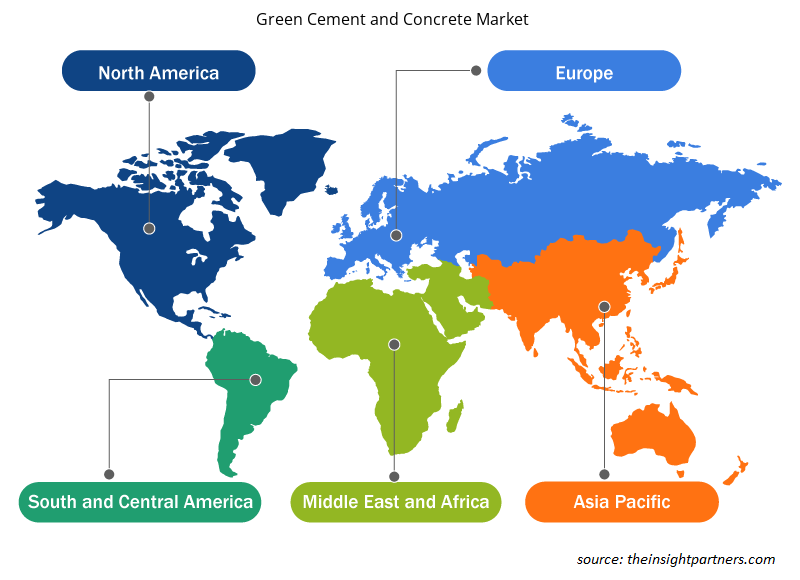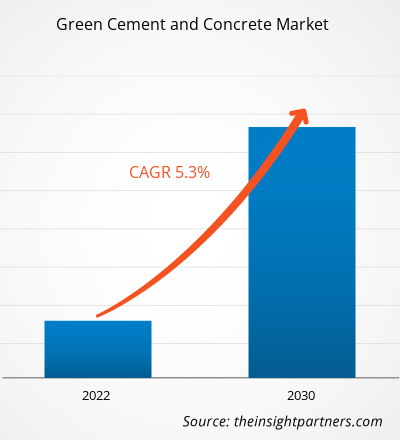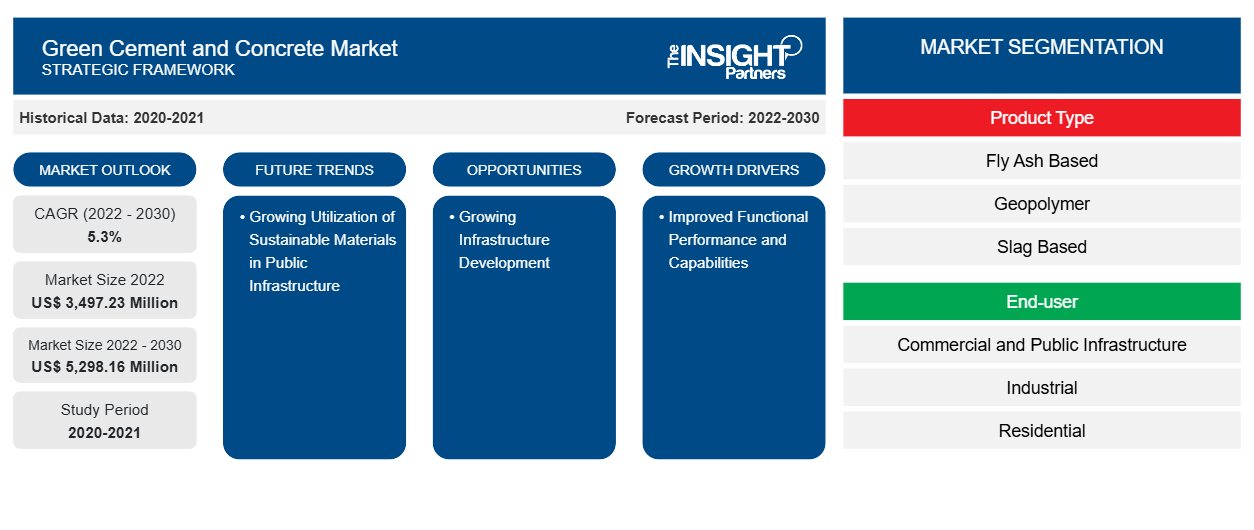Si prevede che la dimensione del mercato del cemento e del calcestruzzo verdi raggiungerà i 5.298,16 milioni di dollari entro il 2030, rispetto ai 3.497,23 milioni di dollari del 2022. Si prevede che il mercato registrerà un CAGR del 5,3% nel 2022-2030. Numerosi paesi stanno implementando roadmap per la decarbonizzazione dell'industria del cemento, aumentando la domanda di cemento e calcestruzzo verdi a livello globale.
Analisi del mercato del cemento e del calcestruzzo verdi
L'industria del cemento è una delle principali industrie incentrate sul carbonio, che si prevede avrà un impatto negativo sulla protezione ambientale. Pertanto, la crescente preoccupazione per la mitigazione dell'impatto del carbonio sull'ambiente e l'attenzione verso approcci di sostenibilità sempre più mirati sono destinati a guidare la crescita del mercato del cemento e del calcestruzzo verdi a livello globale.
Panoramica del mercato del cemento e del calcestruzzo verdi
Si prevede che la crescente iniziativa governativa e le politiche incoraggianti stimoleranno l'integrazione di cemento e calcestruzzo verdi sostenibili nelle fondamenta delle infrastrutture pubbliche. Ad esempio, si prevede che diversi progetti infrastrutturali imminenti in India, come il Narmada Valley Development Project, Bharatmala Pariyojana, Chenab River Railway Bridge, Mumbai Trans Harbour Link, Delhi Metro Industrial Corridor e Navi Mumbai International Project, saranno realizzati utilizzando cemento e calcestruzzo verdi. Pertanto, si prevede che la crescente proliferazione del cemento verde come alternativa praticabile al cemento convenzionale manterrà la sua crescente applicazione nel settore delle infrastrutture commerciali e pubbliche.
Personalizza questo report in base alle tue esigenze
Riceverai la personalizzazione gratuita di qualsiasi report, comprese parti di questo report, o analisi a livello nazionale, pacchetto dati Excel, oltre a usufruire di grandi offerte e sconti per start-up e università
-
Scopri le principali tendenze di mercato in questo rapporto.Questo campione GRATUITO includerà analisi di dati che spaziano dalle tendenze di mercato alle stime e alle previsioni.
Driver e opportunità del mercato del cemento e del calcestruzzo verdi
Prestazioni funzionali migliorate e capacità che stimolano la domanda di cemento e calcestruzzo verdi
Il processo di produzione del cemento standard richiede una grande quantità di gas naturale per scopi di riscaldamento. Il cemento verde è fabbricato da sottoprodotti industriali, il che rende il processo di produzione più efficiente dal punto di vista energetico. Il cemento verde presenta una maggiore resistenza al fuoco e richiede meno tempo di presa rispetto ad altri cementi standard. Le costruzioni realizzate utilizzando cemento verde hanno una durata maggiore. Il processo di fabbricazione del cemento verde segue tecniche di fascia alta che possono ridurre le emissioni di carbonio, causando un inquinamento minimo. La produzione di cemento verde richiede l'applicazione di sottoprodotti, come scorie di altoforno, silice di ceneri volanti e ferro, che sono convenienti. Il cemento verde possiede lo 0,5-0,6% di biossido di ferro nelle sue proprietà, che offre resistenza alla solidità e al colore del cemento. Questo cemento si asciuga rapidamente e ha un tasso minimo di restringimento. Dura più a lungo e costituisce un'alternativa più sostenibile per l'ambiente. Il cemento verde offre anche un isolamento termico di fascia alta e resistenza al fuoco. Il cemento verde è un'alternativa più adatta per aree ad alto traffico come strade, ponti e aeroporti, poiché può supportare carichi pesanti. Pertanto, le prestazioni più elevate del cemento verde e le sue capacità in termini di durata, resistenza e robustezza ne stimolano il mercato.
Sviluppo delle infrastrutture in crescita: un’opportunità nel mercato del cemento e del calcestruzzo verdi
I crescenti finanziamenti per infrastrutture sostenibili aprono la strada a opportunità di cemento e calcestruzzo verdi, incrementando l'utilizzo di alternative ecologiche e incoraggiando lo sviluppo economico. Fornisce inoltre un percorso ai paesi per incorporare i loro obiettivi di sviluppo infrastrutturale e climatici in linea partecipando a progetti che riducono la presenza di carbonio, inclusi ecosistemi di costruzione e produzione sostenibili e verdi. Il settore delle costruzioni e delle infrastrutture si sta concentrando sulla riduzione della sua impronta di carbonio, in quanto è il principale fattore che contribuisce all'inquinamento ambientale. Pertanto, si prevede che una crescente attenzione al cemento e al calcestruzzo verdi nello sviluppo delle infrastrutture fornirà grandi opportunità per il mercato.
Analisi della segmentazione del rapporto di mercato del cemento e del calcestruzzo verdi
I segmenti chiave che hanno contribuito alla derivazione dell'analisi del mercato del cemento e del calcestruzzo verdi sono il tipo di prodotto e l'utente finale.
- In base al tipo di prodotto, il mercato del cemento e del calcestruzzo verdi è stato suddiviso in a base di ceneri volanti, geopolimeri, a base di scorie e altri. Il segmento a base di ceneri volanti ha detenuto una quota di mercato maggiore nel 2022.
- In base all'utente finale, il mercato del cemento e del calcestruzzo verdi è stato suddiviso in infrastrutture commerciali e pubbliche, industriali e residenziali. Il segmento delle infrastrutture commerciali e pubbliche ha detenuto una quota di mercato maggiore nel 2022.
Analisi della quota di mercato del cemento e del calcestruzzo verdi per area geografica
L'ambito geografico del rapporto sul mercato del cemento e del calcestruzzo verdi è suddiviso principalmente in cinque regioni: Nord America, Asia Pacifico, Europa, Medio Oriente e Africa e Sud America/Sud e Centro America.
Le crescenti preoccupazioni ambientali e l'attenzione all'utilizzo di alternative sostenibili nell'industria del cemento stanno guidando la crescita del mercato del cemento e del calcestruzzo verdi nell'area Asia-Pacifico. Paesi come Cina e India, principali produttori di cemento, hanno identificato la necessità di passare a pratiche di produzione del cemento più rispettose dell'ambiente. Inoltre, i governi di vari paesi stanno adottando varie misure per attrarre finanziamenti privati nei progetti di sviluppo infrastrutturale. L'espansione degli investimenti nei progetti di costruzione residenziale e commerciale sta aumentando la domanda di materiali edilizi avanzati, tra cui soluzioni di cemento e calcestruzzo verdi , nei paesi dell'area Asia-Pacifico.
Approfondimenti regionali sul mercato del cemento e del calcestruzzo verdi
Le tendenze regionali e i fattori che influenzano il Green Cement and Concrete Market durante il periodo di previsione sono stati ampiamente spiegati dagli analisti di Insight Partners. Questa sezione discute anche i segmenti e la geografia del Green Cement and Concrete Market in Nord America, Europa, Asia Pacifico, Medio Oriente e Africa e Sud e Centro America.

- Ottieni i dati specifici regionali per il mercato del cemento e del calcestruzzo verdi
Ambito del rapporto sul mercato del cemento e del calcestruzzo verdi
| Attributo del report | Dettagli |
|---|---|
| Dimensioni del mercato nel 2022 | 3.497,23 milioni di dollari USA |
| Dimensioni del mercato entro il 2030 | 5.298,16 milioni di dollari USA |
| CAGR globale (2022-2030) | 5,3% |
| Dati storici | 2020-2021 |
| Periodo di previsione | 2022-2030 |
| Segmenti coperti |
Per tipo di prodotto
|
| Regioni e Paesi coperti |
America del Nord
|
| Leader di mercato e profili aziendali chiave |
|
Densità degli attori del mercato del cemento e del calcestruzzo verdi: comprendere il suo impatto sulle dinamiche aziendali
Il mercato del cemento e del calcestruzzo verdi sta crescendo rapidamente, spinto dalla crescente domanda degli utenti finali dovuta a fattori quali l'evoluzione delle preferenze dei consumatori, i progressi tecnologici e una maggiore consapevolezza dei benefici del prodotto. Con l'aumento della domanda, le aziende stanno ampliando le loro offerte, innovando per soddisfare le esigenze dei consumatori e capitalizzando sulle tendenze emergenti, il che alimenta ulteriormente la crescita del mercato.
La densità degli operatori di mercato si riferisce alla distribuzione di aziende o società che operano in un particolare mercato o settore. Indica quanti concorrenti (operatori di mercato) sono presenti in un dato spazio di mercato in relazione alle sue dimensioni o al valore di mercato totale.
Le principali aziende che operano nel mercato del cemento e del calcestruzzo verdi sono:
- Cemento ACC (Gruppo Adani)
- Società cinese di materiali edilizi a responsabilità limitata (CNBM)
- Cemento verde Inc.
- Cemento di conchiglia di Anhui
- Società anonima Holcim Ltd.
- JSW Cemento Limitato
Disclaimer : le aziende elencate sopra non sono classificate secondo un ordine particolare.

- Ottieni una panoramica dei principali attori del mercato del cemento e del calcestruzzo verdi
Notizie e sviluppi recenti sul mercato del cemento e del calcestruzzo verdi
Il mercato del cemento e del calcestruzzo verdi viene valutato raccogliendo dati qualitativi e quantitativi dopo la ricerca primaria e secondaria, che include importanti pubblicazioni aziendali, dati associativi e database. Di seguito è riportato un elenco degli sviluppi nel mercato per innovazioni, espansione aziendale e strategie:
- Nel febbraio 2023, Holcim ha avviato la prima attività di produzione di cemento di argilla calcinata in Europa nel suo stabilimento di Saint-Pierre-la-Cour in Francia, per fornire cemento verde ECOPlanet con un'impronta di CO2 inferiore del 50% rispetto al cemento standard (CEM I). (Fonte: Holcim Ltd., comunicato stampa/sito Web aziendale/newsletter)
- A settembre 2023, Hoffmann Green Cement Technologies ha firmato un accordo di partnership con Point. P. In base ai termini dell'accordo, i prodotti cementizi senza clinker di HGCT vengono distribuiti agli impianti di calcestruzzo preconfezionato (RMC) e di betonaggio di Point. P. (Fonte: Hoffmann Green Cement Technologies, comunicato stampa/sito Web aziendale/newsletter)
Copertura e risultati del rapporto sul mercato del cemento e del calcestruzzo verdi
Il rapporto "Dimensioni e previsioni del mercato del cemento e del calcestruzzo verdi (2020-2030)" fornisce un'analisi dettagliata del mercato che copre le seguenti aree:
- Dimensioni e previsioni del mercato del cemento e del calcestruzzo verdi a livello globale, regionale e nazionale per tutti i segmenti di mercato chiave coperti dall'ambito
- Dinamiche di mercato come fattori trainanti, vincoli e opportunità chiave
- Tendenze del mercato del cemento e del calcestruzzo verdi
- Analisi PEST e SWOT dettagliate
- Analisi del mercato del cemento e del calcestruzzo verdi che copre le principali tendenze del mercato, il quadro globale e regionale, i principali attori, le normative e i recenti sviluppi del mercato
- Analisi del settore del cemento e del calcestruzzo verdi, panorama e concorrenza, che copre la concentrazione del mercato, l'analisi della mappa termica, i principali attori e gli sviluppi recenti
- Profili aziendali dettagliati
- Analisi storica (2 anni), anno base, previsione (7 anni) con CAGR
- Analisi PEST e SWOT
- Valore/volume delle dimensioni del mercato - Globale, Regionale, Nazionale
- Industria e panorama competitivo
- Set di dati Excel
Report recenti
Rapporti correlati
Testimonianze
Motivo dell'acquisto
- Processo decisionale informato
- Comprensione delle dinamiche di mercato
- Analisi competitiva
- Analisi dei clienti
- Previsioni di mercato
- Mitigazione del rischio
- Pianificazione strategica
- Giustificazione degli investimenti
- Identificazione dei mercati emergenti
- Miglioramento delle strategie di marketing
- Aumento dell'efficienza operativa
- Allineamento alle tendenze normative























 Ottieni un campione gratuito per - Mercato del cemento e del calcestruzzo verdi
Ottieni un campione gratuito per - Mercato del cemento e del calcestruzzo verdi